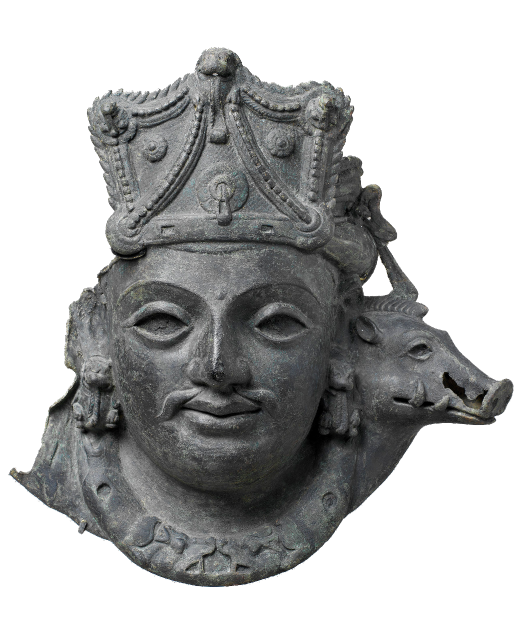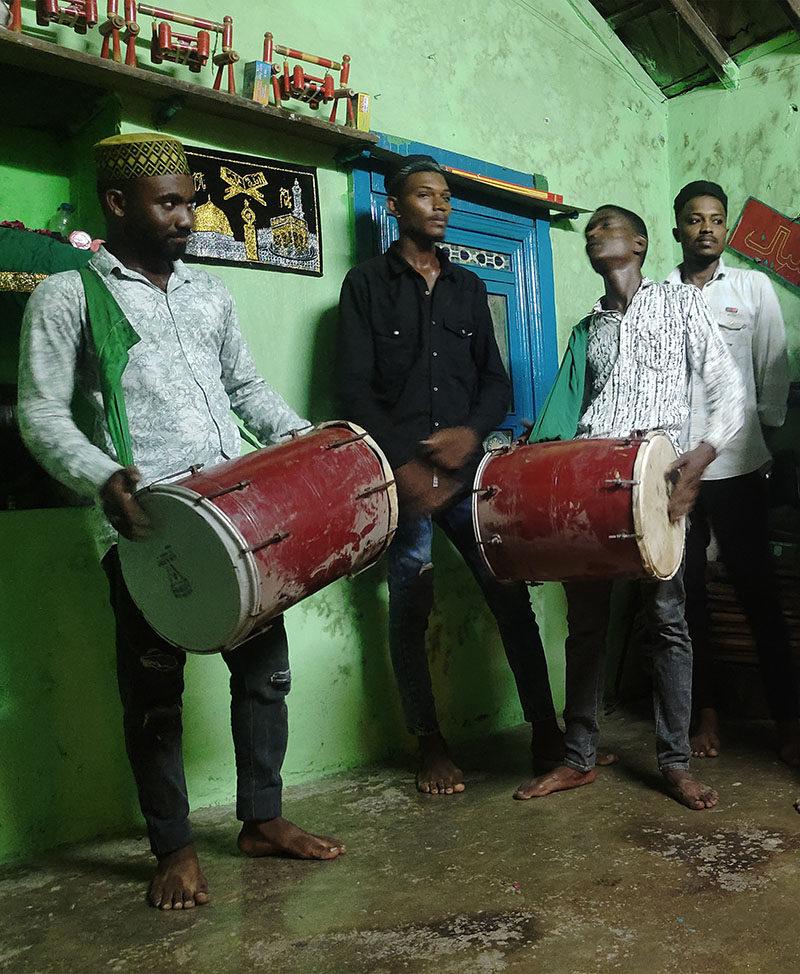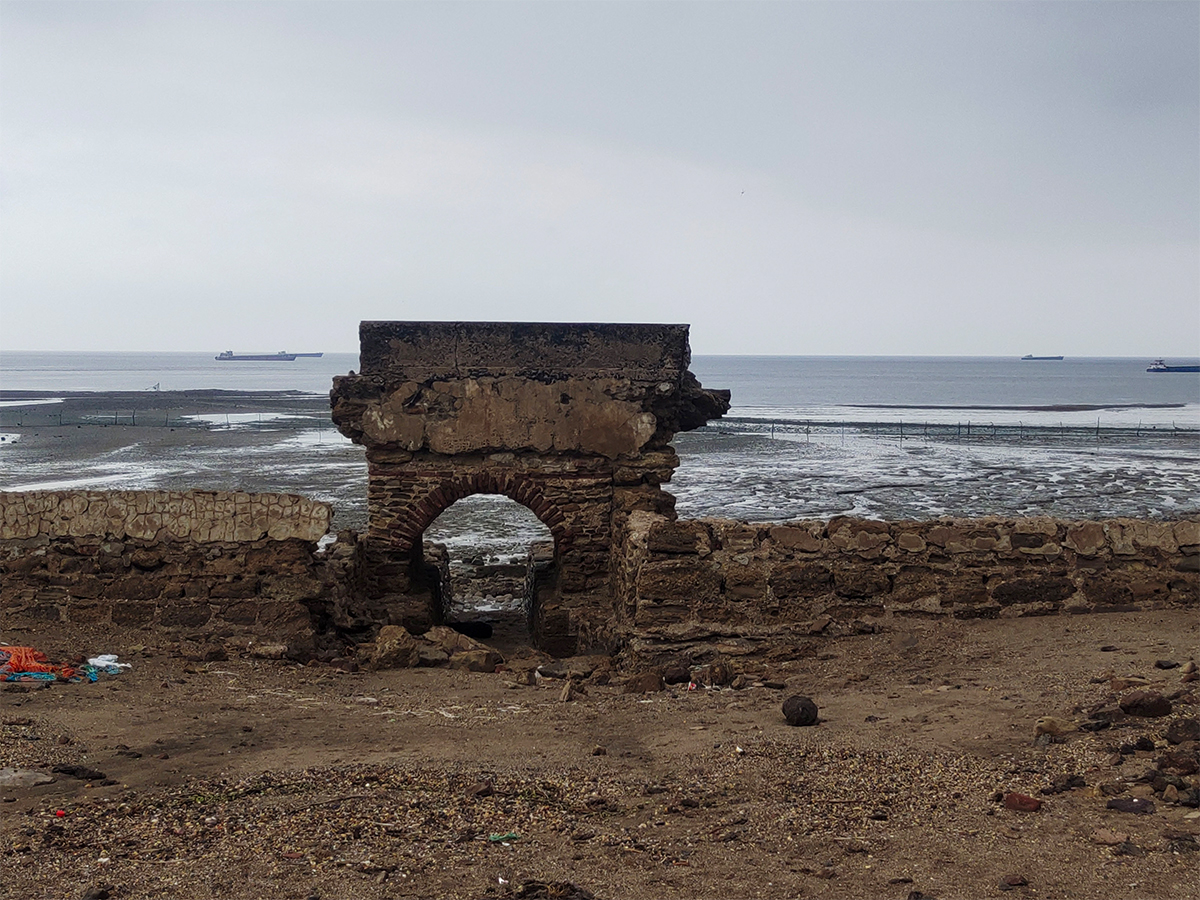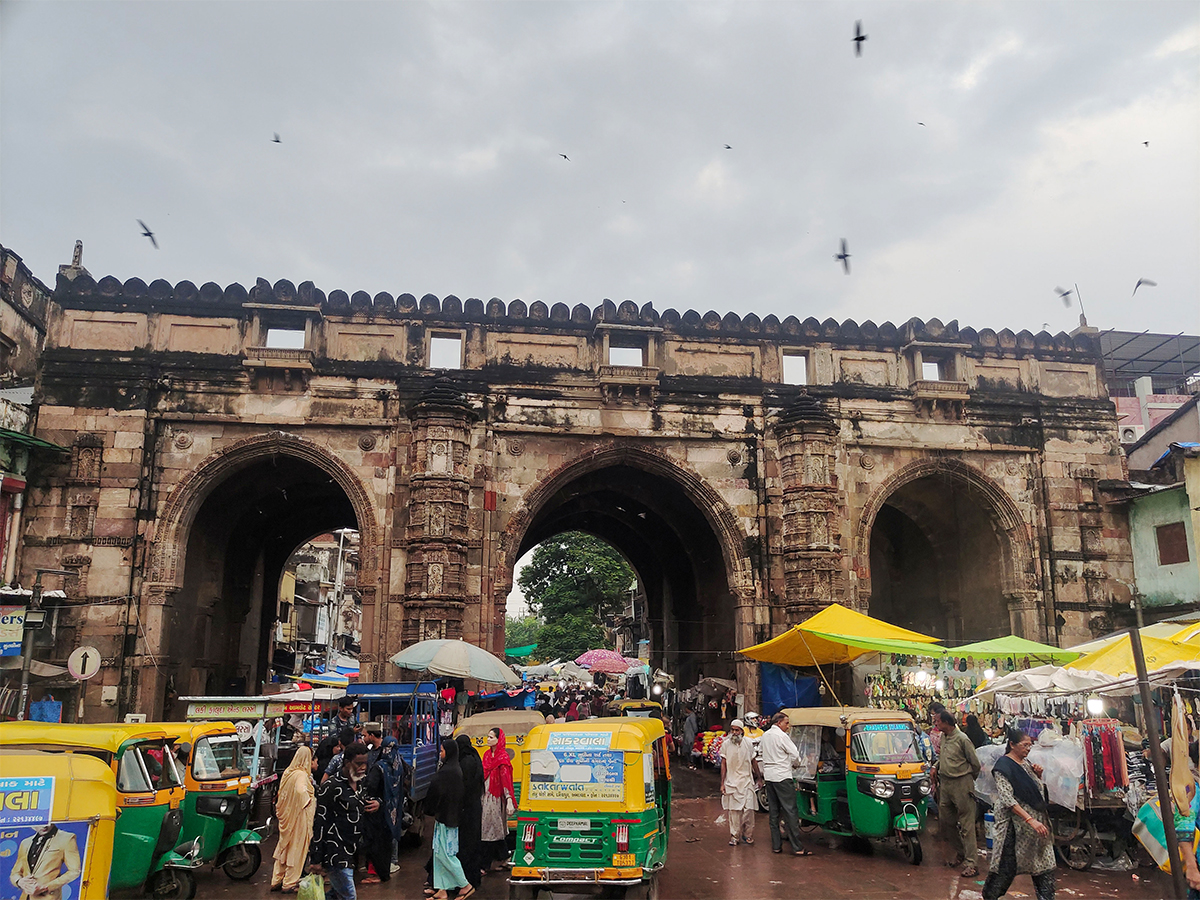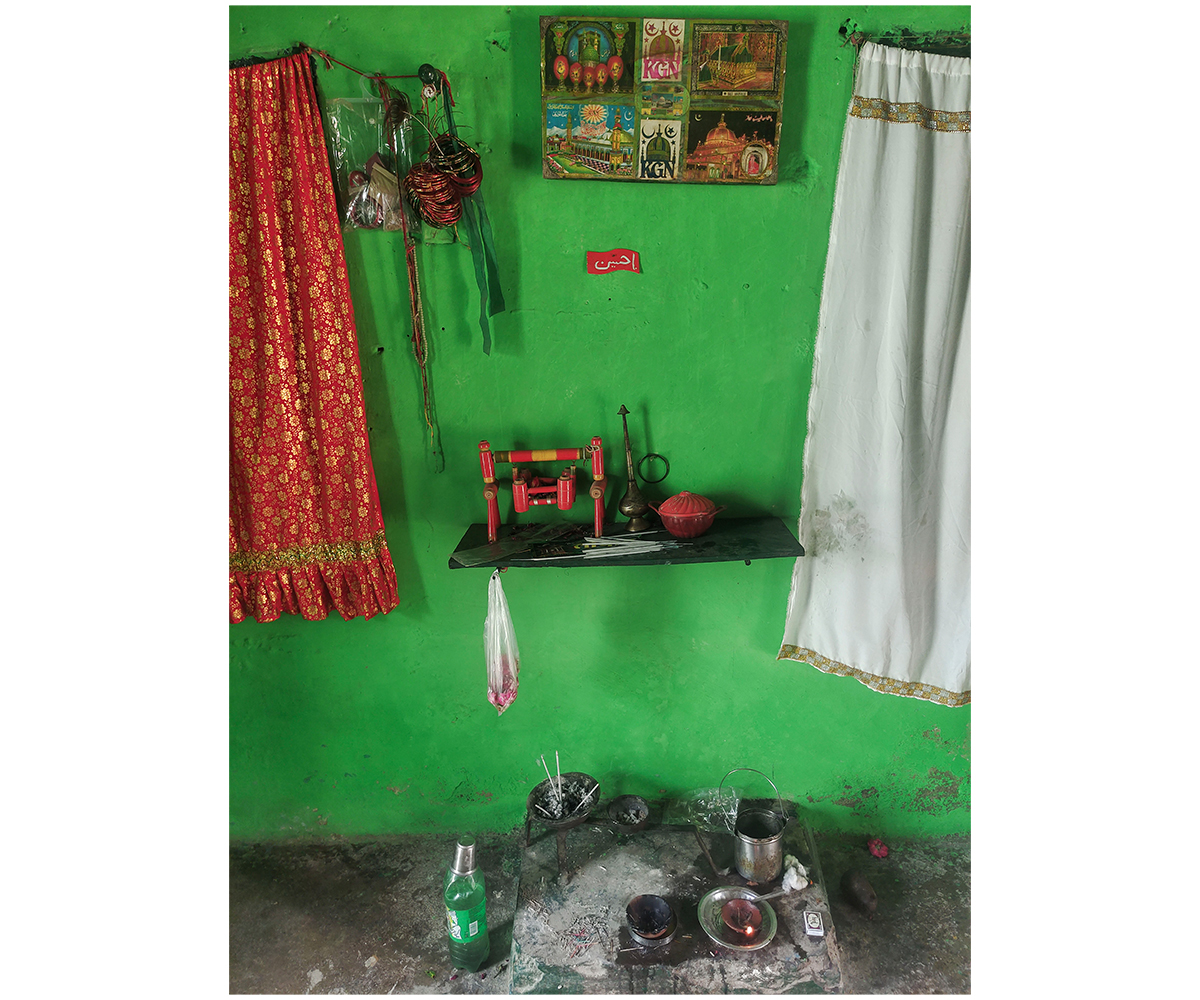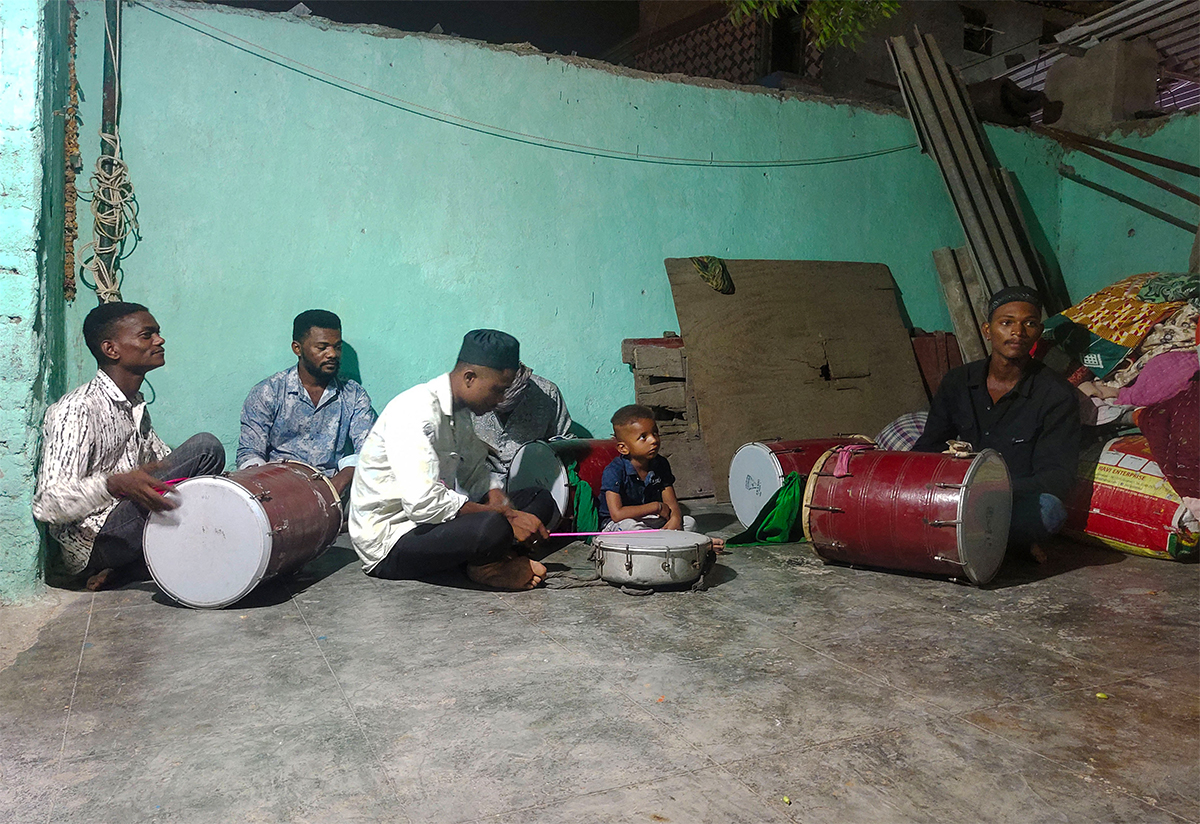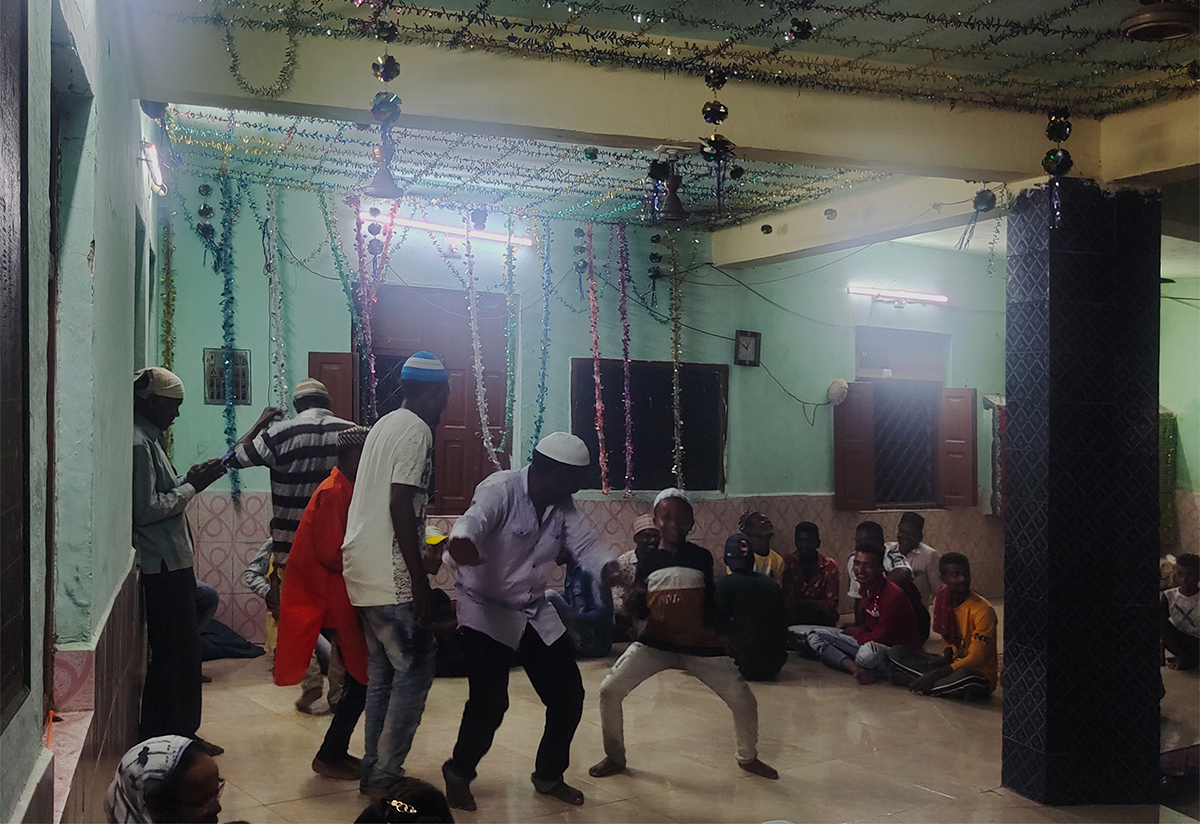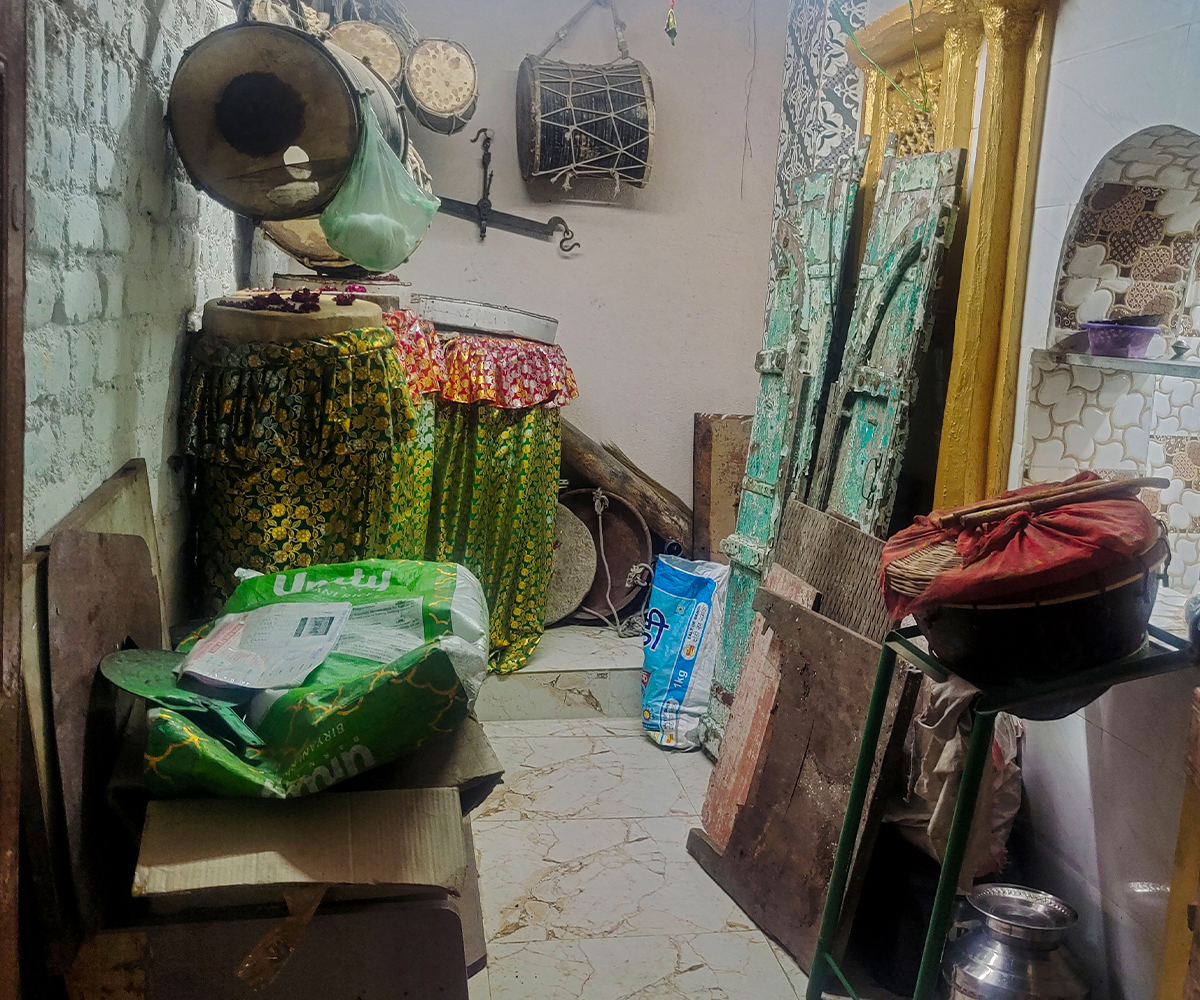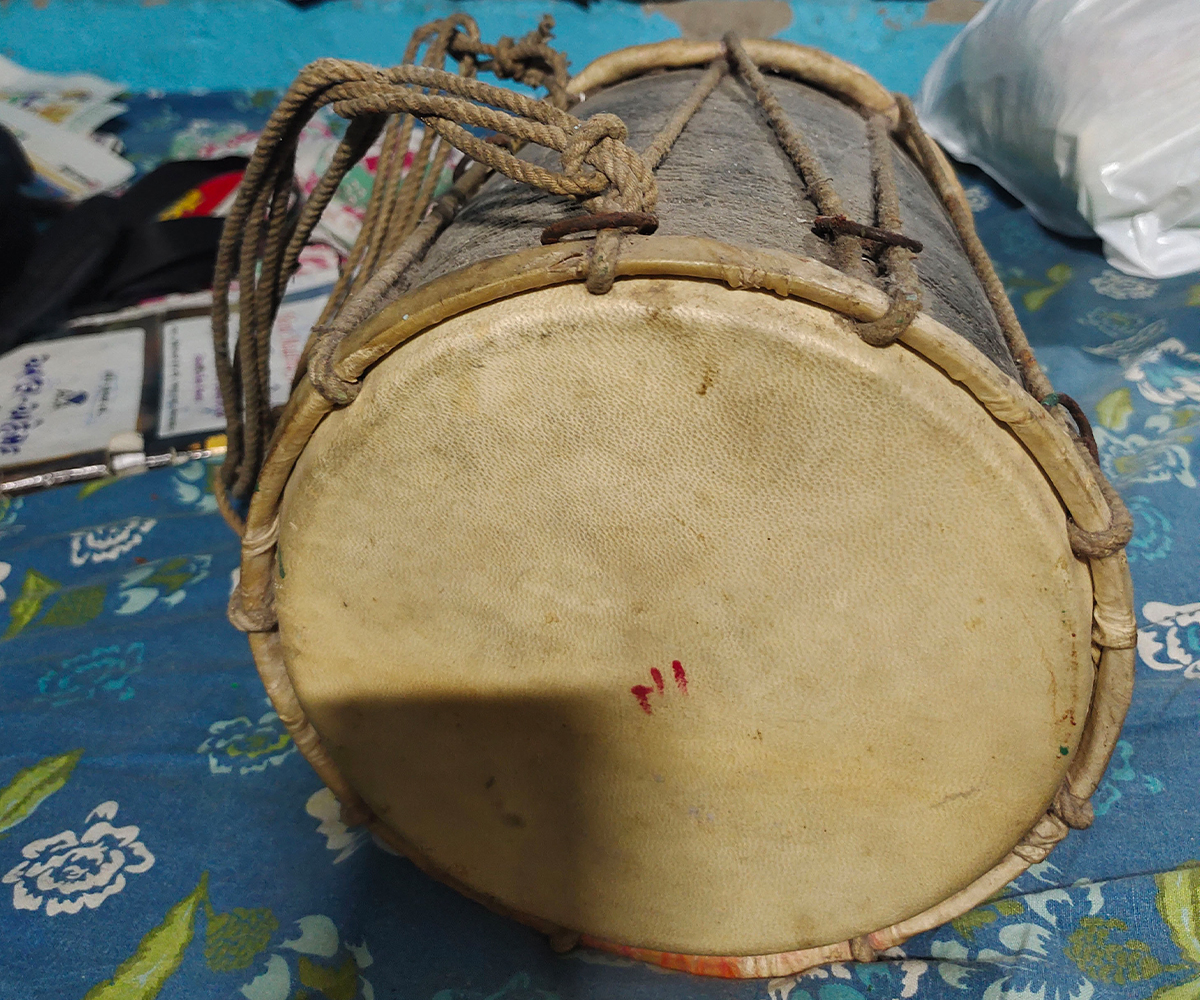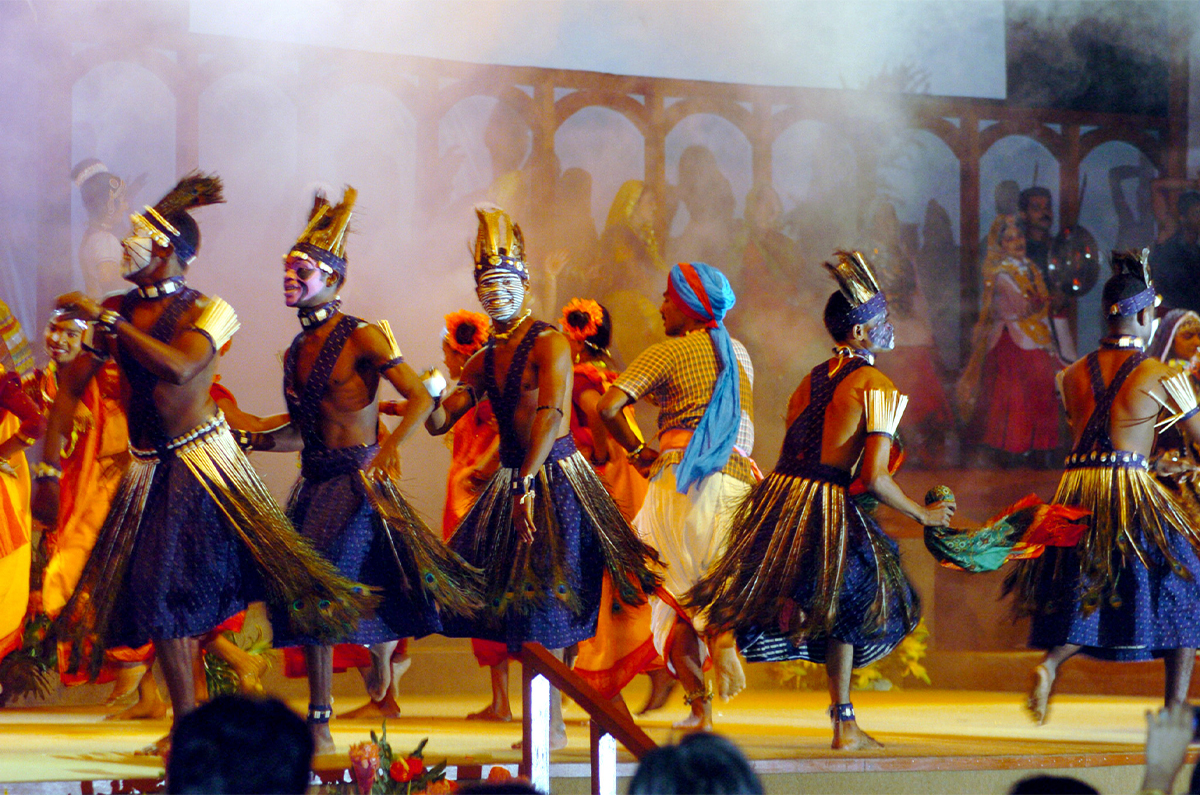ARTICLE
Siddi Dhamaal
With the formal abolition of slavery in the nineteenth century, ‘Siddi’ as a broad cultural identity began to be consolidated in Gujarat, and spread to Sindh (as ‘Sheedi’). Myth-making and new kinship norms linked diverse groups of African-origin people — besides formerly enslaved people and their descendants, these included seamen, labourers, servants, runaways, as well as descendants of Abyssinian Habshi kings and clans long settled in various parts of India. Siddi dhamaal grew out of the music, movement and ritual practices that these varied groups had developed over the previous centuries as means of mutual communication and identification across their own language and cultural barriers. Siddi groups outside Gujarat and Sindh additionally developed their own syncretic cultural forms shaped by their local milieus.
Spiritual origins
The corpus of myth and ritual that began to take shape in Gujarat included a cosmology influenced by popular local Sufism. Bantu spirits and mythical ancestors were refigured as Sufi patron saints of the Siddi. Especially prominent was the cult of three mythical ancestors who were figured as the kulpir (lineage deities) of Muslim Siddi people: Bava Gor or Gori Pir — historically described as an East African agate merchant likely named Siddi Mubarak Nobi, who sailed to South Asia — his brother Bava Habash, and sister Mai Mishra; today, most Siddi dhamaal performances honour these ancestor-saints. A shrine for Bava Gor had been built in Gujarat well before the nineteenth century but the cult was spread further by Siddi freedmen who took on the role of fakirs, mediating the healing powers of the saints for lay people and, according to historical sources, performing what was likely an early form of Siddi dhamaal. More shrines were built with grants from local rulers, and served as spaces for the Siddi to congregate and develop this and other communal practices.
This emerging community established itself as a distinct jamat (organisation or caste) of Muslims in Gujarat and Sindh. Their integration of Sufi devotionalism also allowed them to adopt and translate South Asian Sufi practices of dhamaal — an ecstatic trance-like dance in which participants are often possessed by the spirit of a saint — through their own knowledge of a range of music, dance and ritual practices. These practices are known in Bantu languages as ngoma — a term that refers variously to a type of drum; to singing, dancing or drumming in a call-and-response format; and generally to cults of spirit possession and healing in which these movement practices are ritually important. Ngoma found resonance both in South Asian folk beliefs about spirits and their role in affliction and healing, and in Sufi dhamaal, a practice that itself emerged from an earlier blending of Islam and South Asian folk religion. The Indic term ‘dhamaal’, like ‘ngoma’, refers variously to enjoyment or cavorting, wildness, certain types of songs, and the fire-walking of ascetics. The singing of zikr — Sufi songs or chants — was also adapted into Siddi ritualism. A distinctly Siddi style of dhamaal emerged, also known as goma.
Siddi communities in other parts of India also adopted the worship of these saints, though most are less grounded in Islam and have adopted local forms of Hinduism to a greater degree; however, even in Gujarat, the Siddi have adopted some aspects of folk Hinduism, sometimes honouring Hindu goddesses with dhamaal performances.
Performance formats
Siddi dhamaal or goma involves call-and-response singing and percussion, circular dancing — with clear East African movement styles and rhythmic patterns influenced by South Asian Sufi performance — and spirit possession. A dhamaal performer is often referred to as a dhamaali; importantly, though there are now professional touring groups of dhamaal performers, the practice is not considered specialised and is open to any member of the Siddi community.
Siddi dhamaal is practised in two formats, though they are not mutually exclusive: baithaki dhamaal, in which performers sing while seated, often led by older women of the community; and dance dhamaal, which is more energetic and places a greater emphasis on rhythmic drumming. The performance is often inaugurated by the blowing of a conch shell. A prolonged dhamaal session often starts in a slow-tempo baithaki format and eventually gathers energy and speed as people begin to dance. Major Siddi ritual observances culminate in a session that goes on for several hours, often well into the night. Formal recordings or detailed descriptions of ritual Siddi dhamaal are scarce.
Instruments
Both types of Siddi dhamaal are characteristically accompanied by a range of East African instruments: the musindo (a cylindrical two-sided drum), the djembe (one-sided goblet drum), the mbira or its smaller variant the kalimba (a wooden board with metal tines that are plucked by hand), the mugarman (a cylindrical one-sided drum), the goma (one-sided Bantu drum), and the malunga (a single-stringed bow with a gourd resonator, to be struck by the hand or a stick). The malunga is typically accompanied by the misr kanga or mai misra (Ethiopian funnel-shaped rattle filled with small stones), named for the eponymous Siddi saint and often played to accompany zikrs honouring her. The South Asian harmonium and dholak also feature prominently alongside these. Dhamaal performances for the proscenium sometimes feature a nagara.
Use of the malunga declined and nearly disappeared from Siddi dhamaal by 2000; in recent decades ethnomusicologists Nazir Jairazbhoy and Amy Catlin-Jairazbhoy have worked to revive it through training camps for Siddi practitioners.
Zikr singing
Baithaki dhamaal performers sing zikrs from a corpus of over a hundred Siddi songs that invoke ancestors and sometimes describe events from Islamic history or Siddi cultural memory and folklore. The rhythm of these songs typically follows established patterns of the South Asian Sufi style of zikr singing. Zikrs are meant to invite the saints to be present and impart their blessings, and also to induce a state of trance in which participants may embody the saints through possession. Many of these are in Urdu or Swahili Creole, which blends East African Kiswahili with Gujarati, Balochi, Hindi and Urdu. Amy Catlin-Jairazbhoy has also recorded zikrs entirely in an old Bantu language, though these are rarely performed today; they also note that Siddi zikrs in Karnataka do not include Swahili words.
Dance
In dance dhamaal, drumming becomes more prominent than in baithaki dhamaal, though zikrs also continue to be sung to accompany the performance. The repertoire of movements is similar to those of East African ngoma dance; performers often stomp their feet and swing their arms rhythmically, though the intensity of the stepping may be less in more solemn ritual contexts. The movements may be stylised to imitate animals, trees or bodies of water. Dancers start off in a circle, with the drummers playing in the centre. Men and women dance together, unlike in other South Asian Sufi shrines.
Some participants enter a state of trance or possession, in which their movements are often playful, erratic, or acrobatic — conventional norms of behaviour and movement are not expected to be followed. Some may throw coconuts in the air and attempt to break them with their heads as they fall; this is considered a feat that can only be accomplished by one who has truly received a saint’s blessing. The state of ecstasy or trance, known as hal (Arabic, ‘state’ or ‘condition’) in Sufism, is often referred to as maja (Urdu, ‘fun’ or ‘pleasure’) by the Siddi — a state achieved by true devotion to the patron saint and facilitated by the drumming, singing and dancing of dhamaal.
Shrines and ritual contexts
Dhamaal is practised at various stages of Siddi Sufi ritual observance: during the preparation of food offerings to deities/saints, healing or initiation ceremonies, the consecration of shrines, ritual processions, and culminating celebrations. These take place at Siddi shrines in Gujarat and Sindh, primarily in veneration of the three major Siddi patron saints, as well as the Prophet Muhammad and other deified ancestors. Outside Gujarat, shrines (chillas) for Siddi saints are also found in Mumbai, where Siddi dancers from Gujarat are invited to perform at important ritual observances.
Two major Siddi dargahs in Gujarat — in Bharuch and the Gir Forest — and a Parsi chilla for the Siddi saints in Dongri, Mumbai, host large-scale, multi-day celebrations to commemorate urs, the death anniversaries of the saints. These shrines attract pilgrims of various faiths, all of whom share a belief in the healing powers of the Siddi saints, though only the Siddi participate in dhamaal. The first stage of the urs celebration — the consecration and anointing of ritual objects associated with each saint — is opened with baithaki dhamaal to invite their presence. A procession is then undertaken, accompanied by drummers and singers, often with select members serving as spirit mediums. The objects are then installed at the shrine and dance dhamaal commences to celebrate the presence and powers of the saints.
At the Manghopir shrine in Karachi, Pakistan, the Sheedi gather to celebrate Sheedi Jaat, a festival honouring their patron saint Mor Mubarak. Dhamaal accompanies the ritual feeding of sacred crocodiles at the shrine, said to have been given by Mor Mubarak as a gift to the community.
Contemporary forms and challenges
In post-Independence India, the Siddi of Gujarat have faced marginalisation both by orthodox, upper-caste Muslim leaders and by caste Hindus. Loss of the patronage they received in precolonial India also led to economic challenges for the community. In the 1980s, the Siddi were designated a Scheduled Tribe of Gujarat, following which they have been invited to perform dhamaal at various public and private functions and for tourists. Siddi performance groups such as Siddi Goma have travelled across India and internationally, including to Zanzibar, where they performed at the 2003 Indian Ocean Film Festival.
However, the form that the performance takes in such secular contexts is markedly different from dhamaal in ritual practice, shaped significantly by commercial interests and popular misconceptions of African cultures. The choreography is fixed, faster, and more acrobatic. While dhamaal participants at shrines wear everyday clothes with no special adornments, professional troupes wear face paint, feathered costumes with headdresses, and accessories made of cowrie shells. Accounts of the origin of this costume vary, but many performers claim that its use was instituted by outsiders seeking to evoke popular stereotypical notions of Africa. These costumes are strictly prohibited in sacred Siddi spaces and are viewed by many Siddi as degrading.
In response to these challenges, Siddi organisations such as the Siddi Goma Al-Mubrik Charitable Trust in Bhavnagar, Samast Sidi Jamat in Jamnagar, and Siddi Education Mandal and Siddi Mai Misra Pragati Mahila Mandal in Ahmedabad have made efforts towards the cultural education and empowerment of community members — especially of younger Siddi — by emphasising the preservation of their ancestral knowledge and artistic practices.
Bibliography
Ali, O. “The African Diaspora in the Indian Ocean World.” The University of North Carolina at Greensboro. 2011. https://core.ac.uk/reader/149239078.
Basu, Helene. “History on the Line: Music and the Formation of Sidi Identity in Western India.” History Workshop Journal 65, no. 1 (2008): 161–78. https://doi.org/10.1093/hwj/dbm069.
Basu, Helene. “Slave, Soldier, Trader, Faqir: Fragments of African Histories in Western India (Gujarat).” In The African Diaspora in the Indian Ocean, edited by Shihan de Silva Jayasuriya and and Richard Pankhurst. Trenton, NJ and Asmara, Eritrea: Africa World Press, Inc. 2003
Bhattacharya, D. K. “Indians of African Origin.” Cahiers d’Études Africaines 10, no. 40 (1970): 579–82. http://www.jstor.org/stable/4391096.
Catlin-Jairazbhoy, A., and E. A. Alpers (eds.). Sidis and Scholars : Essays on African Indians. Noida: Rainbow Publishers. 2004
Curtis, Edward E. The Call of Bilal: Islam in the African Diaspora. University of North Carolina Press, 2014.
Dasgupta, Anuran. “Dancing African-ness: The Transnational Identity of the Siddi Dammal.” In Fire Under My Feet: History, Race and Agency in African Diaspora Dance, edited by Ofusuwa M. Abiola. Routledge, 2022.
Dey, Sayan. “Baine Maara-Indu Mama-Siddi Dhamal: Interwoven Performances of Epistemic Justice and Cognitive Freedom by the Siddis of Karnataka, India.” International Journal of Critical Diversity Studies 5, no. 2 (2022): 17–32. https://www.jstor.org/stable/48755787.
Dey, Sayan. Performing Memories and Weaving Archives: Creolized Cultures across the Indian Ocean. London: Anthem Press, 2024. https://doi.org/10.2307/jj.8973372.
Frembgen, Jürgen Wasim. “Dhamāl and the Performing Body: Trance Dance in the Devotional Sufi Practice of Pakistan.” Journal of Sufi Studies 1 (2012): 77–113. https://doi.org/10.1163/221059512X626126.
Graves, Jazmin. “Through the Eyes of the Lyre: A Transoceanic Perspective of the Sidi Sufi Devotional Tradition of Western India.” In African Diasporan Communities across South Asia, edited by Omar H. Ali, et al. Greensboro: University of North Carolina Ethiopian and East African Studies Project, 2020.
Modi, Renu. “Africans in India, Past and Present.” In Global Africa: Into the Twenty-First Century, edited by Dorothy L. Hodgson and Judith A. Byfield. Oakland: University of California Press, 2017.
Pankhurst, Richard. “The Ethiopian Diaspora to India: The Role of Habshis and Sidis from Medieval Times to the End of the Eighteenth Century.” In The African Diaspora in the Indian Ocean, edited by Shihan de Silva Jayasuriya and Richard Pankhurst. Trenton, NJ and Asmara, Eritrea: Africa World Press, Inc. 2003
Péquignot, Sofia. “From ‘Afro-Indians’ to ‘Afro-Global’ Networking: Contemporary Identification and Unification Processes among Siddis.” South Asian History and Culture 11, no. 4 (2020): 449–64. https://doi.org/10.1080/19472498.2020.1827599.
P. S., Arun. “Siddis in India: The Unexplored Legacy of Africa’s Diaspora.” Journal of Indian History 99 (2022): 147–59. https://jihku.org/wp-content/uploads/2024/09/8.pdf.
Rao, Madanmohan. “Interview with Sidi Goma, African Indian Sidis from Gujarat.” World Music Central, July 7, 2012. Accessed November 25, 2024. https://worldmusiccentral.org/2012/07/07/interview-with-sidi-goma-african-indian-sidis-from-gujarat/.
Shroff, Beheroze. “‘Goma Is Going On’: Sidis of Gujarat.” African Arts 46, no. 1 (2013): 18–25. http://www.jstor.org/stable/43306122.
